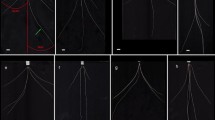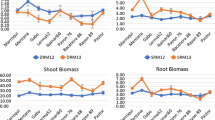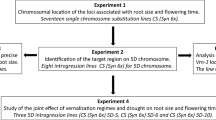Abstract
Wild crop relatives are of considerable interest in plant breeding and significant efforts have been made to transfer their genetic variation into modern crops. Of the three diploid progenitors of bread wheat (Triticum aestivum L.), only Aegilops tauschii Coss. has been explored and exploited and only for some above ground characteristics. The three wild progenitors (Aegilops speltoides Tausch., Triticum urartu Tumanian ex Gandilyan, and Aegilops tauschii) have never been assayed for root traits. Here we report such a root study, and include Triticum monococcum L. subsp. boeoticum (Boiss.) Hayek and T. turgidum L. subsp. dicoccoides (Koern. ex Asch. et Graebn.) Thell. Fifteen accessions were selected from the above wild species and tested in the presence of one bread wheat cultivar Pavon F76. Significant variation was observed between and within the taxa. Of all accessions tested, cv. Pavon F76 had the smallest root system at maturity while A. speltoides had the largest root system. Moreover, Aegilops spp. had larger mean values for root biomass when compared with Triticum spp. These results suggest there is significant unexplored potential for the use of wheat wild relatives in wheat breeding to improve the root system, or to develop synthetic mapping populations to study root traits.


Similar content being viewed by others
References
Assefa S, Fehrmann H (2000) Resistance to wheat leaf rust in Aegilops tauschii Coss. and inheritance of resistance in hexaploid wheat. Genet Resour Crop Evol 47:135–140. doi:10.1023/A:1008770226330
Blum A (1996) Crop responses to drought and the interpretation of adaptation. Plant Growth Regul 20:135–148. doi:10.1007/BF00024010
Dubcovsky J, Dvorak J (2007) Genome plasticity a key factor in the success of polyploid wheat under domestication. Science 316:1862–1866
Ehdaie B, Waines J (2006) Determination of a chromosome segment influencing rooting ability in wheat-rye 1BS-1RS recombinant lines [Triticum aestivum L.; Secale cereale L.]. J Genet Breed (Italy) 60:71–76
FAOSTAT (2014) Food balance sheet. Food Agriculture Organization of the United, Nations, Rome
Feuillet C, Langridge P, Waugh R (2007) Cereal breeding takes a walk on the wild side. Trends Genet 24:24–32. doi:10.1016/j.tig.2007.11.001
Frankel OH, Bennett E (eds) (1970) Genetic resources in plants: their exploration and conservation. International Biological Programme. Blackwell Scientific Publications, Oxford
Górny AG, Garczyński S (2008) Nitrogen and phosphorus efficiency in wild and cultivated species of wheat. J Plant Nutr 31:263–279. doi:10.1080/01904160701853878
Gororo NN, Eagles HA, Eastwood RF, Nicolas ME, Flood RG (2002) Use of Triticum tauschii to improve yield of wheat in low-yielding environments. Euphytica 123:241–254. doi:10.1023/A:1014910000128
Grando S, Ceccarelli S (1995) Seminal root morphology and coleoptile length in wild (Hordeum vulgare ssp. spontaneum) and cultivated (Hordeum vulgare ssp. vulgare) barley. Euphytica 86:73–80
Hajjar R, Hodgkin T (2007) The use of wild relatives in crop improvement: a survey of developments over the last 20 years. Euphytica 156:1–13. doi:10.1007/s10681-007-9363-0
Hegde SG, Valkoun J, Waines JG (2000) Genetic diversity in wild wheats and goat grass. Theor Appl Genet 101:309–316. doi:10.1007/s001220051484
Hegde SG, Valkoun J, Waines JG (2002) Genetic diversity in wild and weedy Aegilops, Amblyopyrum, and Secale species—a preliminary survey. Crop Sci 42:608–614
Herder GD, Van Isterdael G, Beeckman T, De Smet I (2010) The roots of a new green revolution. Trends Plant Sci 15:600–607. doi:10.1016/j.tplants.2010.08.009
Hetrick BAD, Wilson GWT, Cox TS (1992) Mycorrhizal dependence of modern wheat varieties, landraces, and ancestors. Can J Bot 70:2032–2040. doi:10.1139/b92-253
Kara Y, Martín A, Souyris I, Rekika D, Monneveux P (2000) Root characteristics in durum wheat (T. turgidum conv. durum) and some wild Triticeae species. Genetic variation and relationship with plant architecture. Cereal Res Commun 28:247–254. doi:10.2307/23786219
Kihara H (1944) Discovery of the DD-analyser, one of the ancestors of Triticum vulgare. Agric Horticult 19:13–14
Kunert A, Naz A, Dedeck O, Pillen K, Léon J (2007) AB-QTL analysis in winter wheat: I. Synthetic hexaploid wheat (T. turgidum ssp. dicoccoides × T. tauschii) as a source of favorable alleles for milling and baking quality traits. Theor Appl Genet 115:683–695. doi:10.1007/s00122-007-0600-7
Lehmann A, Barto EK, Powell JR, Rillig MC (2012) Mycorrhizal responsiveness trends in annual crop plants and their wild relatives—a meta-analysis on studies from 1981 to 2010. Plant Soil 355:231–250. doi:10.1007/s11104-011-1095-1
Li W, Li T, Chen Y, Li X, Wang H (2004) Effects of chromosomes in D genome from Aegilops tauschii on wheat yield traits. J Trit Crops 25:26–29
Limin A, Fowler D (1981) Cold hardiness of some relatives of hexaploid wheat. Can J Bot 59:572–573
Manschadi AM, Christopher J, deVoil P, Hammer GL (2006) The role of root architectural traits in adaptation of wheat to water-limited environments. Funct Plant Biol 33:823–837. doi:10.1071/FP06055
Manske GGB, Vlek PLG (2002) Root architecture-wheat as a model plant. In: Waisel Y, Eshel A, Kafkafi U (eds) Plant roots: the hidden half. Marcel Dekker, New York, USA, pp 249–259
Moghaddam M, Ehdaie B, Waines JG (2000) Genetic diversity in populations of wild diploid wheat Triticum urartu Tum. ex Gandil. revealed by isozyme markers. Genet Resour Crop Evol 47:323–334. doi:10.1023/A:1008782532505
Mujeeb-Kazi A, Rosas V, Roldan S (1996) Conservation of the genetic variation of Triticum tauschii (Coss.) Schmalh. (Aegilops squarrosa auct. non L.) in synthetic hexaploid wheats (T. turgidum L. s.lat. × T. tauschii; 2n = 6x = 42, AABBDD) and its potential utilization for wheat improvement. Genet Res Crop Evol 43:129–134. doi:10.1007/BF00126756
Narasimhamoorthy B, Gill BS, Fritz AK, Nelson JC, Brown-Guedira GL (2006) Advanced backcross QTL analysis of a hard winter wheat × synthetic wheat population. Theor Appl Genet 112:787–796. doi:10.1007/s00122-005-0159-0
Okamoto Y, Nguyen AT, Yoshioka M, Iehisa JCM, Takumi S (2013) Identification of quantitative trait loci controlling grain size and shape in the D genome of synthetic hexaploid wheat lines. Breed Sci 63:423–429. doi:10.1270/jsbbs.63.423
Orth RA, Bushuk W (1973) Studies of glutenin. III. Identification of subunits coded by the D-genome and their relation to bread making quality. Cereal Chem 50:680–687
Passioura JB (1983) Roots and drought resistance. Agric Water Manag 7:265–280. doi:10.1016/0378-3774(83)90089-6
Reynolds MP, Mujeeb-Kazi A, Sawkins M (2005) Prospects for utilizing plant-adaptive mechanisms to improve wheat and other crops in drought- and salinity-prone environments. Ann Appl Biol 146:239–259. doi:10.1111/j.1744-7348.2005.040058.x
Reynolds M, Dreccer F, Trethowan R (2007) Drought-adaptive traits derived from wheat wild relatives and landraces. J Exp Bot 58:177–186. doi:10.1093/jxb/erl250
Schachtman D, Lagudah E, Munns R (1992) The expression of salt tolerance from Triticum tauschii in hexaploid wheat. Theor Appl Genet 84:714–719
Sharma S, Xu SZ, Ehdaie B, Hoops A, Close TJ, Lukaszewski AJ et al (2011) Dissection of QTL effects for root traits using a chromosome arm-specific mapping population in bread wheat. Theor Appl Genet 122:759–769. doi:10.1007/s00122-010-1484-5
Sheedy JG, Thompson JP, Kelly A (2012) Diploid and tetraploid progenitors of wheat are valuable sources of resistance to the root lesion nematode Pratylenchus thornei. Euphytica 186:377–391. doi:10.1007/s10681-011-0617-5
Sohail Q, Inoue T, Tanaka H, Eltayeb AE, Matsuoka Y, Tsujimoto H (2011) Applicability of Aegilops tauschii drought tolerance traits to breeding of hexaploid wheat. Breed Sci 61:347–357. doi:10.1270/jsbbs.61.347
Steel RGD, Torrie JH, Dickey DA (1997) Principles and procedures of statistics: a biometrical approach. McGraw-Hill, New York
Valkoun J, Waines JG, Konopka J (1998) Current geographical distribution and habitat of wild wheats and barley. In: Damania VJ, Wilcox GAB, Qualset CO (eds) The origin of agriculture and crop domestication. ICARDA, Aleppo, pp 293–299
Witcombe JR, Hollington PA, Howarth CJ, Reader S, Steele KA (2008) Breeding for abiotic stresses for sustainable agriculture. Philos Trans R Soc B 363:703–716. doi:10.1098/rstb.2007.2179
Acknowledgments
The Authors are grateful to Dr. Adam J. Lukaszewski, University of California, Riverside for discussion. This work was supported by the California Agricultural Experiment Station, the University of California, Riverside Botanic Gardens, and a doctoral fellowship of the Turkish Republic Ministry of National Education to Harun Bektas.
Author information
Authors and Affiliations
Corresponding author
Ethics declarations
Conflict of interest
We confirm that this work is original and has not been published elsewhere nor is it currently under consideration for publication elsewhere. Informed consent was obtained from all individual participants included in the study. The authors declare that they have no conflict of interest.
Rights and permissions
About this article
Cite this article
Bektas, H., Hohn, C.E. & Waines, J.G. Characteristics of the root system in the diploid genome donors of hexaploid wheat (Triticum aestivum L.). Genet Resour Crop Evol 64, 1641–1650 (2017). https://doi.org/10.1007/s10722-016-0462-4
Received:
Accepted:
Published:
Issue Date:
DOI: https://doi.org/10.1007/s10722-016-0462-4




